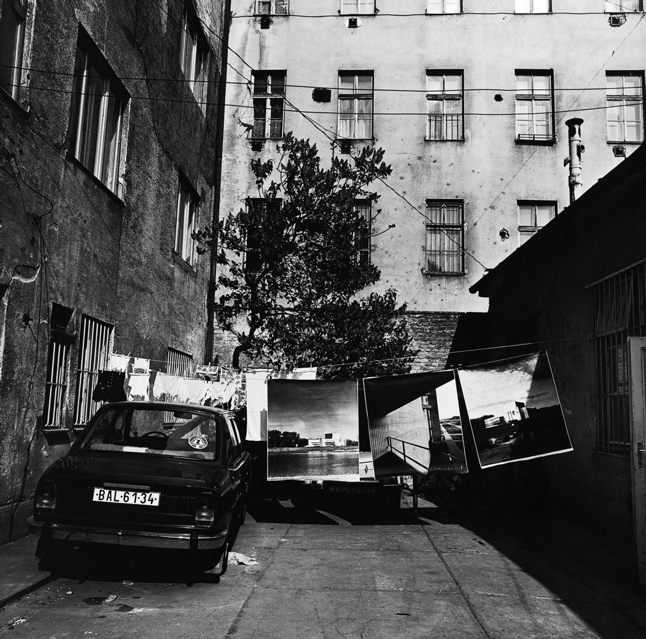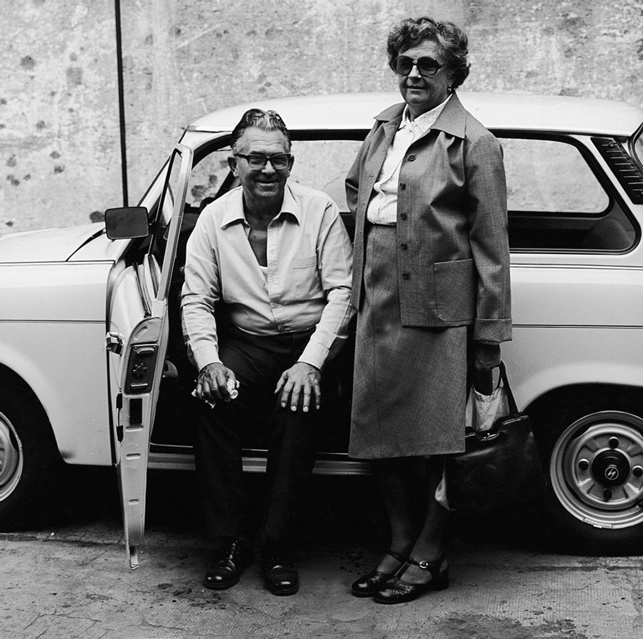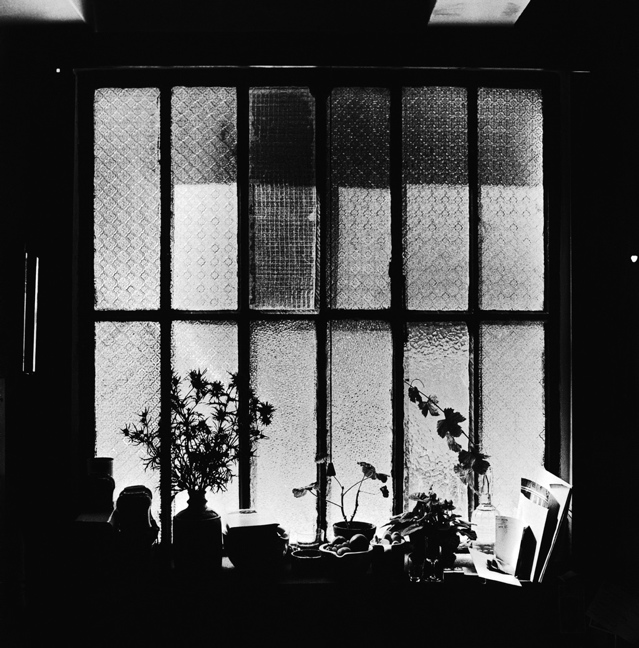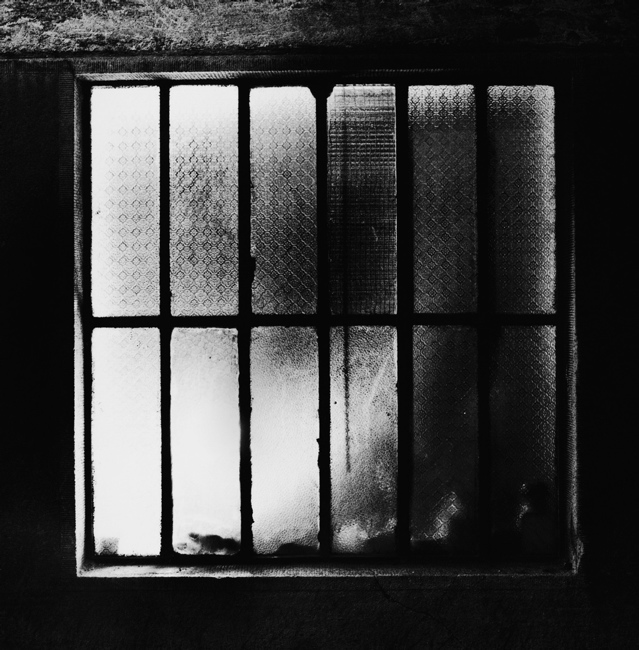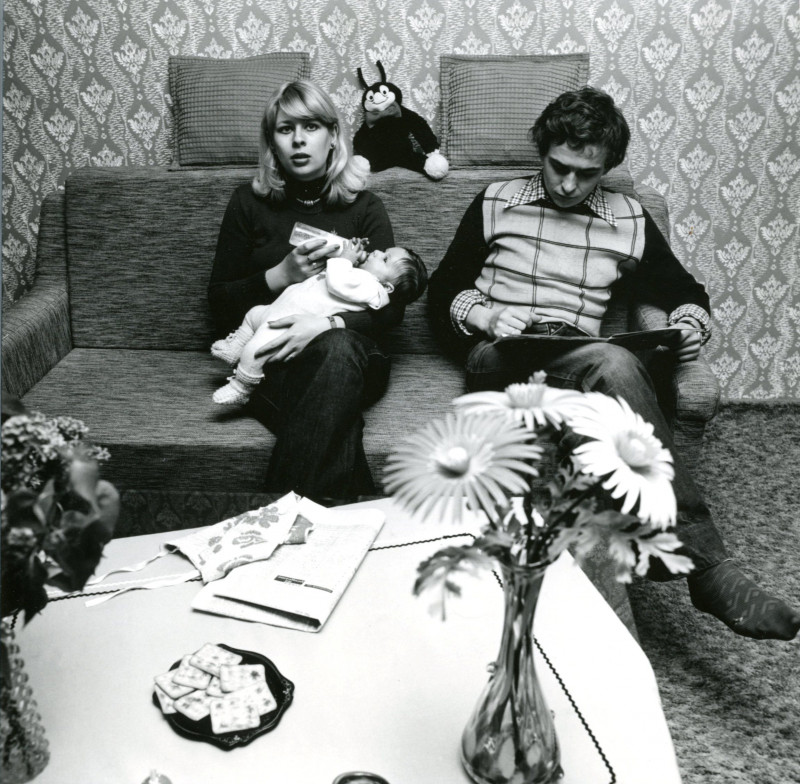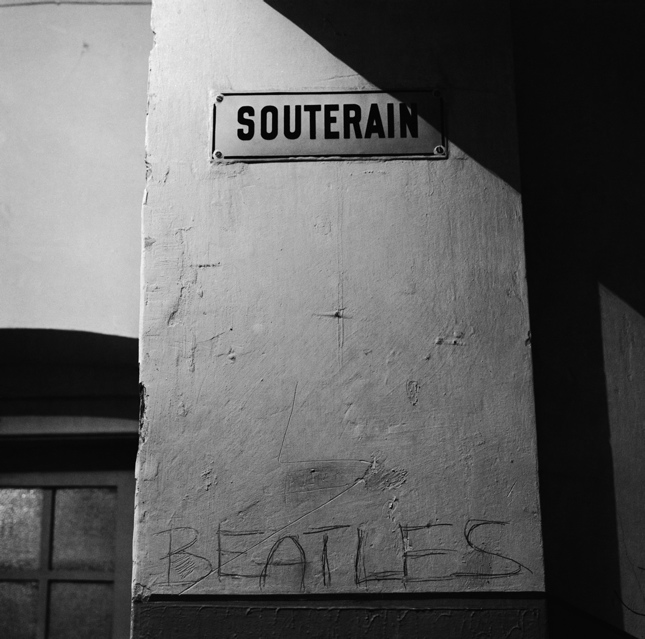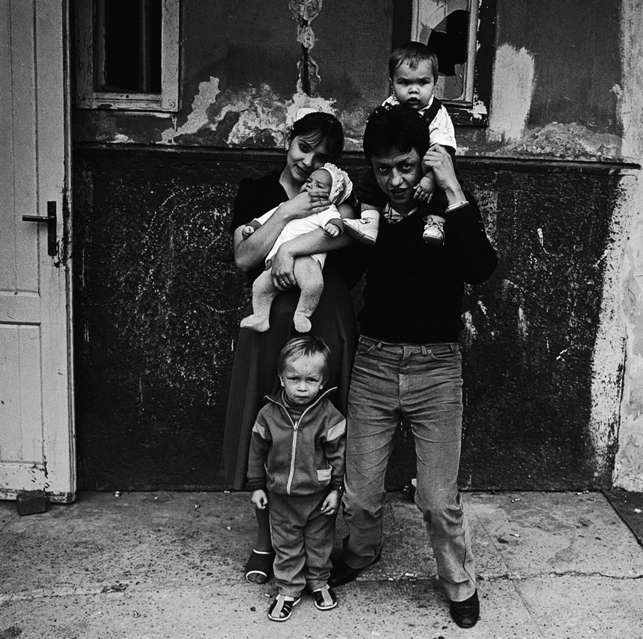The Nitra Gallery collection also includes Ľubo Stacho’s photography timelapse project titled Poultry Showcase, Obchodná street No. 24
The black and white photographs from the Town House I and Town House II series were created during the artist’s academic years at Prague’s FAMU as a part of a term project that focused on documenting urban areas as well countryside and was led by the students’ mentor and well-known photographer Pavel Štecha. Nitra Gallery holds a narrow selection of the otherwise broad spectrum of the project.
In his Town House I series, Stacho documented the lives of people living in a house at Mariánska street in Bratislava, where he also had his own studio. In that sense, he was an insider, an interested party, a part of a community, all of which allowed him an easy access to the intimacy of his neighbours’ homes. His personal record of the community was created by photographing real people in their homes (e.g. a young couple with a baby in their living room) or in the neighbourhood (e.g. an older couple by their car), but also with a group photography of all the residents in front of the house, creating a kind of a stage act within the documentary. The artist also recorded his own presence by photographing the basement window of his studio which he had used for observing everyday life, like people on the sidewalks, but mostly the lighting changes related to the passing time and movements of the sun. The first photograph depicts a still life arrangement on the window sill captured in daylight from inside of the studio. The second one shows the window in the evening, captured from the street, illuminated with an artificial light source from the inside. The artist himself claims the project meant a turning point in his career when he discovered the potential of timelapse, the process of capturing time with photography, which he developed fully in his following projects and it has become one of the key attributes of his creative program. He elaborated on the motif of the window in his later series titled Window into My Studio (1985). Another photograph references Stacho directly and foreshadows his subsequent career development. It captures a courtyard with drying laundry and the artist’s large-format photographs of architecture hanging next to it (during his studies at FAMU, he worked as a photographer for the Association of Slovak Architects between 1979 and 1985). He would later incorporate the presentation technique – hanging photo canvases – in his installations over the course of the 1990s (e.g. Message from Saint Veronica – Laundry Room, Mattress Factory, Pittsburgh, 1995; Canvases of Memories and Forgetting, Synagogue, GJK, Trnava, 1997).
The second series, titled Town House II, continues to map real-life stories. These are related to an apartment building on Čajaková street in Bratislava where he lived with his first wife, Marta Bezúchová Stachová and thus had an intimate knowledge of the surroundings (the original title of the series was the House Where I Live). One of the documented residents was a catholic priest, imprisoned in the 1950s, who would work manual labour after his return from Jáchymov. However, following his beliefs, he would still deliver a sermon in his flat every week to all of the house residents. Stacho does not document the stories of the residents as just individuals living next to each other, but as intertwined and shared life experiences. It is important to note he created two photographs of the priest. He took the first one in 1983 and the second one two years later, in 1985. The Town House II series focuses on twin photographs taken a few years apart from each other. He also used this approach to document a Romany family and their breakup. The first photograph captures a young family with their first child – Christening (1982), but after four years, their father, husband is missing in the picture – Father Has Left the Family (1985). The timelapse technique, or rather a confrontation of two photographs, one of which came from the photographee’s archives, has been fully developed later in his career, specifically in a later project of photography diptychs. Nitra Gallery owns two photographs from the extensive Town House II series – an image of a young five-member Romany family and an image of the actual house. It captures a wall with writings related to its history – the title of the house basement labelled as Souterain (souterraine in French), referring to the period when the house was built and a newer graffiti writing referencing the Beatles, the iconic band of the 1960s.
As Aurel Hrabušický points out, both series – Town House I and Town House II – are composed as photo albums, “arranged as a family photo book” where the photographees are “fate-bound”; and just as in a family photo book “people come and go…, some are added and some leave us as time goes by”1.
Ľubo Stacho has been gradually developing his creative program since the 1970s when he entered the national art scene, originally as an untrained photographer. He started to cultivate his interest in photography while attending a photography club in Nováky, where he lived. Later on, he has completed several photography courses. In 1976, he graduated from the Slovak University of Technology in Bratislava and began to study photography at Prague’s FAMU in 1979. Due to his brother’s emigration and his father’s suspension from the communist party, he was not allowed to be admitted as a full-time student – he was, however, admitted on a second try, but only as a part-time student. He studied under prof. Ján Šmok and adopted precise photographic craftsmanship, which he perceived as an advantage in hindsight. When he started attending FAMU, he was already an established artist with several photographic series in his catalogue that covered various social and psychological moments – some of his motives included miners, students, children with cancer (Tell Me, Bad Disease, 1975-1978). During his studies, he followed his previous creative program (Town House I and II, 1981-1985), but he also developed an eminent interest in timelapse, recording time, the way it passes, the process of various changes, human existence and ephemerality. These themes refer mostly to an open series titled the Manifest of Time (1976-1984). Even though the core of the artist’s work relies on photography, it sometimes leaves its pure form behind and overlaps with other media, mostly objects, installations, video and action art.
— Barbora Geržová, March 2021
Notes
1 Geržová, J. – Hrabušický, A. – Vrbanová, A.: 3 eseje o fotografiách Ľuba Stacha [3 Essays About Ľubo Stacho’s Photographs]. Bratislava: FO ART, 2004, p. 10.
Bibliography
1) Geržová, J. – Hrabušický, A. – Vrbanová, A.: 3 eseje o fotografiách Ľuba Stacha [3 Essays About Ľubo Stacho’s Photographs]. Bratislava: FO ART, 2004.
2) https://www.artdispecing.sk/tv-channel/dialogy-s-vytvarnikmi/lubo-stacho-1-konceptualny-dokument/
Ľubo Stacho was born in 1953 in Handlová. In 1976, he graduated from the Faculty of Civil Engineering at STU in Bratislava and from 1979 to 1984, he studied at the Department of Photography at Prague’s FAMU. In the 1980s, he worked as a public educator and methodist of photography at MDKO [Public Education Association]. From 1987 to 1988, he was in charge of the dramaturgy of the photography gallery Profile which was situated in the foyer of the Pohraničník [Border Patrol] movie theatre. After its cancellation in 1990, he was responsible for its reopening under the same name Profile Gallery (Prepoštská street, Bratislava). In 1990, he started working at the Academy of Fine Arts and Design in Bratislava where he founded the Department of Photography and New Media. He is in charge of its Studio Laboratory of Photography. His works can be found in various galleries, including Slovak National Gallery in Bratislava, Maravian Gallery in Brno, National Gallery in Prague, UMPRUM in Prague, National Library of France, Jane Corkin Gallery in Toronto, Corcoran Gallery in Washington and museums in Houston, New Orleans and Cologne. He has also written about photography and published a monograph of an important photographer with Slovak roots, François Kollar.
Inventory No.:
F 117, F 118, F 119, F 120, F 121, F 122
Artist: Ľubo Stacho
Title: from the Town House I series
Year: 1980 – 1981
Technique: black and white photography
Material: brome-silver photographic paper
Dimensions: 20 x 20 cm
Edition: 4/5
Signature: hand-written in pencil on the back of the photograph: Ľubo Stacho
Inventory No.:
F 123, F 124
Artist: Ľubo Stacho
Title: from the Town House II series
Year: 1980 – 1985
Technique: black and white photography
Material: brome-silver photographic paper
Dimensions: 18 x 18 cm
Edition: 3/5
Signature: hand-written in pencil on the back of the photograph: Ľubo Stacho

